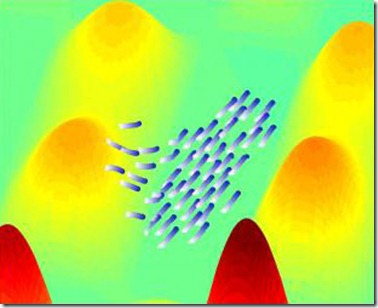Researchers at Tel Aviv University have developed a computational model that better explains how bacteria move in a swarm -- and this model can be applied to human-made technologies, including computers, artificial intelligence, and robotics. The team of scientists has discovered how bacteria collectively gather information about their environment and find an optimal path to growth, even in the most complex terrains.
Studying the principles of bacteria navigation will allow researchers to design a new generation of smart robots that can form intelligent swarms, aid in the development of medical micro-robots used to diagnose or distribute medications in the body, or "de-code" systems used in social networks and throughout the Internet to gather information on consumer behaviors.
 |
Simulated interacting agents collectively navigate towards a target (credit: American Friends of Tel Aviv University)
|
Bacteria aren't the only organisms that travel in swarms. Fish, bees, and birds also exhibit collective navigation. But as simple organisms with less sophisticated receptors, bacteria are not as well-equipped to deal with large amounts of information or "noise" in the complex environments they navigate, such as human tissue. The assumption has been that bacteria would be at a disadvantage compared to other swarming organisms. But in a surprising discovery, the researchers found that computationally, bacteria actually have superior survival tactics, finding "food" and avoiding harm more easily than swarms such as amoeba or fish. Their secret? A liberal amount of self-confidence.
Based on confidence in their own information and decisions, "bacteria can adjust their interactions with their peers," Prof. Ben-Jacob says. "When an individual bacterium finds a more beneficial path, it pays less attention to the signals from the other cells. But at other times, upon encountering challenging paths, the individual cell will increase its interaction with the other cells and learn from its peers. Since each of the cells adopts the same strategy, the group as a whole is able to find an optimal trajectory in an extremely complex terrain."
Robots are often required to navigate complex environments, such as terrains in space, deep in the sea, or the online world, and communicate their findings among themselves. Currently, this is based on complex algorithms and data structures that use a great deal of computer resources. Understanding the secrets of bacteria swarms can provide crucial hints towards the design of new generation robots that are programmed to perform adjustable interactions without taking up a great amount of data or memory.
(Adapted from ScienceDaily)

1 comment:
savannah cat price
savannah cats for sale
savannah kittens
pug puppies for sale
savannah cat for sale
Serval kitten for sale,
savannah kittens for sale, serval cat for sale, savannah cat for sale, savannah cats for sale, f1 savannah cat for sale, serval cat for sale, exotic cats for sale, f1 savannah cat, f4 savannah cat, cats for sale, savannah cats, Serval kittens for sale, savannah kittens for sale near me, savannah cats for sale near me, bengal kittens for sale, bengal kittens for sale near me.
Post a Comment